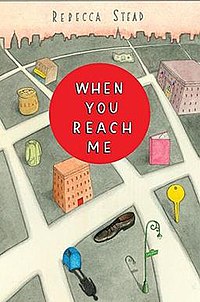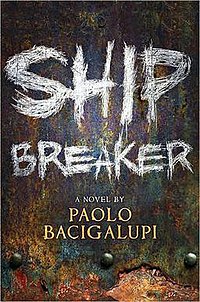1. BIBLIOGRAPHY
Krosoczka, Jarrett. 2009. LUNCH LADY AND THE LEAGUE OF LIBRARIANS.
Ill. by Jarrett Krosoczka. New York, NY: Random House Children's Books, a division of Random
House, Inc. ISBN 9780375846847
2. PLOT SUMMARY
This graphic novel tells the story of three students and two lunch
ladies who work to thwart the evil plans of the League of Librarians. The
students are excited about the upcoming read-a-thon, but are also looking
forward to the release of the newest video game. The librarians feel the video
games are evil and hatch a plan to destroy all video games and video game
consoles. When the students and lunch ladies hear of this plan, they work together
to stop the destruction of all video games. Although the librarians have
powerful weapons in ferocious book characters, the lunch ladies use their lunch
gadgets to fight back. In the end, the librarians are arrested, the video games
are saved, and the read-a-thon is a success. The lunch ladies even implement a "read
while you wait your turn" policy for all students wanting to play video
games in the library (Krosoczka, 2009).
3.
CRITICAL ANALYSIS
Krosoczka creates believable characters in the
students, librarians, and lunch ladies. It is easy for readers to identify with
these characters because they are familiar faces all children interact with at
school. Clever naming strategies for the characters contribute to the humor and
wit of the book. For example, the league of librarians consists of several
committee members, including "Vivian Bookwormer" and "Jane
Shelver" (Krosoczka, 2009). Student and adult readers alike are likely to
chuckle at these references.
The action packed plot keeps the
reader engaged and excited. Early on in the book, Krosoczka reveals to
the reader the secret plot the librarians are planning to execute. "Step
one: Destroy all video games" is the first step in the librarians' plan to
eliminate video games (Krosoczka, 2009). The plot thickens as the students
attempt to involve the lunch ladies in their investigation of the suspicious
librarians. The lunch ladies ask the students, "are you trying to blow our
cover?" (Krosoczka, 2009). The fantasy nature of this graphic novel is
further defined by the students' quest to solve the mystery of the League of
Librarians. "We'll gather more evidence […] This could be more dangerous
than the last mission" (Krosoczka, 2009). Readers will be excited to
venture on this journey with the students as they attempt to save the day by
defeating the evil librarians. Finally, the plot is logical and sequential due
to Krosoczka's use of transitional phrases to show the passing of time. Phrases
such as "after school," "after lunch," or "later"
help to signal to the reader the natural progression of the plot (Krosoczka,
2009).
Although Krosoczka creates a fantasy plot in
this graphic novel, he emphasizes reality by setting the novel at a school. Students
will enjoy reading about a typical school building with the ideas of world dominance,
secret powers, and magical gadgets in the mix. Young readers will be very
familiar with the locations mentioned in the book such as the library, book
fair, and cafeteria, making this an enjoyable book with which students will
readily identify.
A theme in this book is the importance and
value of reading. Although it is evident that the boys and girls at the school
enjoy technology and video games, it is also apparent that reading is another
popular pastime. For example, Dee shares her opinion when she mentions to
Hector, "everyone's life doesn't revolve around electronics"
(Krosoczka, 2009). Dee expresses her excitement for reading when she pledges to
"win this Read-a-thon!" (Krosoczka, 2009). Further support of reading
is seen in the illustration of the book fair. The reader sees a library full of
eager students browsing books for purchase. Students even try to connect their
love of video games to reading. "I'm going to see if they have any books
on video games" (Krosoczka, 2009). Krosoczka makes it very clear that even
though students enjoy technology, reading is still of high importance.
Krosoczka's style is characterized by a significant
use of witty humor. Funny scenes give the book a light-hearted feel. For
example, the lunch ladies' experimentation with night vision goggles is likely to
garner a laugh or two. "It makes everything look like a taco!" the
lunch lady exclaims (Krosoczka, 2009). Krosoczka's use of the graphic novel
style of writing allows him to incorporate sensory details through the use of onomatopoeias.
"FWOMP," "BLEEP, BLEEP," and "RUMBLE" are just a
few of the words that allow the reader to experience the sounds of the school. The
use of onomatopoeias also contributes to the action packed plot Krosoczka uses
to create an engaging storyline. Finally, the use of full page illustrations with supplemental text offers a break in the pattern of the multiple boxes of text found on most pages. These
full page scenes emphasize key points in the plot and require the reader to
pause momentarily before continuing on in the story. For example, a towering librarian
fills the page as she shouts, "The library is CLOSED!" (Krosoczka,
2009).
Krosoczka's use of black, white, and yellow
sketches are consistent with that of most graphic novels. However, rather than
using harsh features found in the traditional graphic novel, Krosoczka employs more
child-friendly illustrations with cartoon like features and rounded edges. Light
and dark contrast helps to convey the evil plot of the librarians. As the lunch
ladies review their secret footage, the room is black and dark revealing the
secret nature of their undercover job. Movement is evident throughout the
illustrations by the use of arrows, lines, and exaggerated gestures. For example, as
the lunch ladies enter their secret area in the boiler room, the reader sees a
hand turning a combination lock. An arrow and the word "click" show
that the lunch ladies were able to successfully enter their secret chamber
(Krosoczka, 2009). Overall,
the action-packed illustrations help create an engaging graphic novel that is
likely to hold its readers captive until the last page.
4. PERSONAL
RESPONSE: STRENGTHS AND WEAKNESSES
I
really enjoyed the subtle humor in this book. I found myself entertained by the
clever use of library terms such as "Vivian Bookwormer" and "media
specialist" (Krosoczka, 2009). However, I felt the book was slightly
confusing. I understood that the librarians wanted to eliminate video games,
but I was never quite sure why they were so unwelcoming and rude to the
students throughout the novel. It seems as though they would have wanted to
make the library an inviting place, especially if they were trying to destroy
all video games. One other fault was the lack of page numbers. The omission of
this access point made the citation of specific examples in the book
challenging.
5. REVIEW EXCERPT(S)
"With its
appealing mix of action and humor, this clever, entertaining addition to the
series should have wide appeal." (SCHOOL LIBRARY JOURNAL)
"This tongue-in-cheek graphic novel series, illustrated
in bold black-and-white with vibrant highlighter-yellow accents, is a strong
choice for superhero-spoof fans." (HORN BOOK)
6. CONNECTIONS
*Students
could read another book in the LUNCH LADY series such as LUNCH LADY AND THE
CYBORG SUBSTITUTE (ISBN 0375846832).
*Students could write a persuasive letter to the librarians
convincing them to abort their plan to destroy all video games.
*A read-a-thon (like the one in the book) could be held
in the school library. Video games, computer games, or board games could be
played. Of course students would participate in reading as they waited for a
turn on one of the games.

